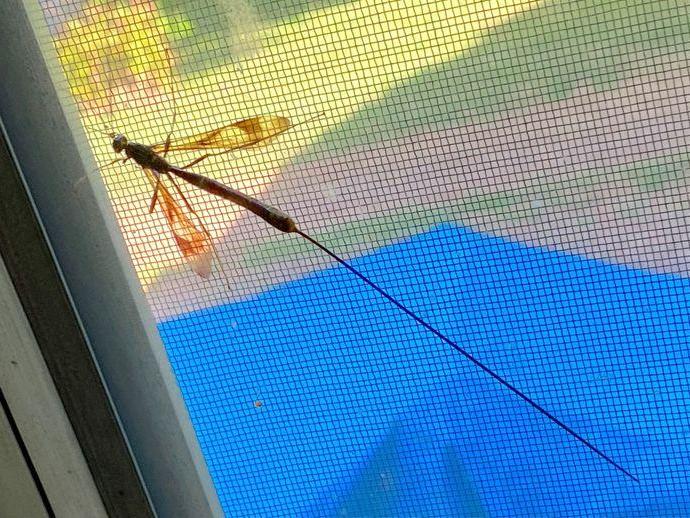July 12, 2021
It's time for today's edition of #BenInNature presented by our friends at Carter Bank & Trust!
I'll be the first to admit that this isn't a great picture; the subject flew away while I was frantically scrabbling to grab a real camera. However, this critter is so interesting that I'm going to do a post about it anyway. The people need to know about Megarhyssa macrurus, the long-tailed giant ichneumon wasp!
First things first, that long black stinger-looking thing is indeed part of the wasp, making this one of the longest (if not THE longest) insects you'll find in Virginia! However, we have nothing to fear from this wasp because that isn't actually a stinger. It's an ovipositor, which is a tube-like organ that most female insects use to lay eggs. So why does this ichneumon wasp need a bizarrely long ovipositor? I'm glad you asked!
When it comes time to lay her eggs, the female long-tailed giant ichneumon seeks out the larvae of an insect called Tremex columba, the pigeon horntail. Pigeon horntail larvae don't exactly hang out in the open, though; they live inside and feed on dead or dying trees, mostly oak, maple, beech, and elm. The female giant ichneumon will land on a likely-looking tree and begin drumming on it with her long antennae, attempting to sense the movements of the horntail larvae living inside. Once she finds one, she uses her long ovipositor to slowly drill a hole right through the wood! Depending on how hard the wood is, this process might take just a few minutes, or it might take a few hours.
Once her ovipositor has punched through the wood and entered the tunnel where the horntail larva lives, the ichneumon will jab it with her ovipositor to paralyze it and then lay her eggs. Once the eggs hatch, the ichneumon larvae will eat the horntail larva, become pupae, and then emerge from the tree as adults the following summer.
Amazingly enough, it's believed that long-tailed giant ichneumon ovipositors are hardened with zinc and/or ionized manganese, making this ovipositor the insect equivalent of a diamond-tipped drill bit!
ABOUT #BenInNature
Social distancing can be difficult, but it presents a great opportunity to become reacquainted with nature. In this series of posts, Administrator of Science Ben Williams ventures outdoors to record a snapshot of the unique sights that can be found in the natural world. New updates are posted Monday - Friday, with previous posts highlighted on the weekends. This series of posts is made possible thanks to the support of VMNH Corporate Partner Carter Bank & Trust (www.cbtcares.com).
NATURE PHOTO IDENTIFICATIONS
If you discover something in nature that you would like help identifying, be sure to message us right here on Facebook with a picture (please include location and date of picture) and we'll have our experts help you identify it!

 Hours & Admissions
Hours & Admissions Directions
Directions

